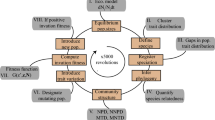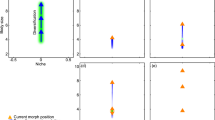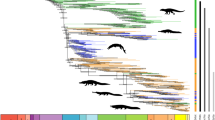Abstract
In the fossil record, taxa exhibit a regular pattern of waxing and waning of occupancy, range or diversity between their origin and extinction. This pattern appears to contradict the law of constant extinction1, which states that the probability of extinction in a given taxon is independent of that taxon’s age. It is nevertheless well established for species, genera and higher taxa of terrestrial mammals2,3,4, marine invertebrates5,6,7, marine microorganisms8, and recent Hawaiian clades of animals and plants9. Here we show that the apparent contradiction between a stochastically constant extinction rate and the seemingly deterministic waxing and waning pattern of taxa disappears when we consider their peak of expansion rather than their final extinction. To a first approximation, we find that biotic drivers of evolution pertain mainly to the peak of taxon expansion, whereas abiotic drivers mainly apply to taxon extinction. The Red Queen’s hypothesis1, which emphasizes biotic interactions, was originally proposed as an explanation of the law of constant extinction. Much effort has since been devoted to determining how this hypothesis, emphasizing competition for resources, relates to the effects of environmental change. One proposed resolution is that biotic and abiotic processes operate at different scales10. By focusing attention on taxon expansion rather than survival, we resolve an apparent contradiction between the seemingly deterministic waxing and waning patterns over time and the randomness of extinction that the Red Queen’s hypothesis implies.
This is a preview of subscription content, access via your institution
Access options
Access Nature and 54 other Nature Portfolio journals
Get Nature+, our best-value online-access subscription
$29.99 / 30 days
cancel any time
Subscribe to this journal
Receive 51 print issues and online access
$199.00 per year
only $3.90 per issue
Buy this article
- Purchase on Springer Link
- Instant access to full article PDF
Prices may be subject to local taxes which are calculated during checkout



Similar content being viewed by others
References
Van Valen, L. A new evolutionary law. Evol. Theory 1, 1–30 (1973)
Jernvall, J. & Fortelius, M. Maintenance of trophic structure in fossil mammal communities: site occupancy and taxon resilience. Am. Nat. 164, 614–624 (2004)
Quental, T. B. & Marshall, C. R. How the Red Queen drives terrestrial mammals to extinction. Science 341, 290–292 (2013)
Carotenuto, F., Barbera, C. & Raia, P. Occupancy, range size, and phylogeny in Eurasian Pliocene to recent large mammals. Paleobiology 36, 399–414 (2010)
Foote, M. et al. Rise and fall of species occupancy in Cenozoic fossil mollusks. Science 318, 1131–1134 (2007)
Tietje, M. & Kiessling, W. Predicting extinction from fossil trajectories of geographical ranges in benthic marine molluscs. J. Biogeogr. 40, 790–799 (2013)
Raia, P. et al. Progress to extinction: increased specialisation causes the demise of animal clades. Sci. Rep. 6, 30965 (2016)
Liow, L. H. & Stenseth, N. C. The rise and fall of species: implications for macroevolutionary and macroecological studies. Proc. R. Soc. Lond. B 274, 2745–2752 (2007)
Lim, J. Y. & Marshall, C. R. The true tempo of evolutionary radiation and decline revealed on the Hawaiian archipelago. Nature 543, 710–713 (2017)
Barnosky, A. D. Distinguishing the effects of the Red Queen and Court Jester on Miocene mammal evolution in the northern Rocky Mountains. J. Vertebr. Paleontol. 21, 172–185 (2001)
Marshall, C. R. Five palaeobiological laws needed to understand the evolution of the living biota. Nat. Ecol. Evol. 1, 0165 (2017)
Van Valen, L. Energy and evolution. Evol. Theory 1, 179–229 (1976)
Van Valen, L. Evolution as a zero-sum game for energy. Evol. Theory 4, 289–300 (1980)
Rannikko, J., Žliobaite˙, I. & Fortelius, M. Relative abundances and palaeoecology of four suid genera in the Turkana Basin, Kenya, during the late Miocene to Pleistocene. Palaeogeogr. Palaeoclimatol. Palaeoecol. 487, 187–193 (2017)
Raup, D. M., Gould, S. J., Schopf, T. J. M. & Simberloff, D. S. Stochastic models of phylogeny and the evolution of diversity. J. Geol. 81, 525–542 (1973)
Cornette, J. L. & Lieberman, B. S. Random walks in the history of life. Proc. Natl Acad. Sci. USA 101, 187–191 (2004)
Pigot, A. L., Owens, I. P. F. & Orme, C. D. L. Speciation and extinction drive the appearance of directional range size evolution in phylogenies and the fossil record. PLoS Biol. 10, e1001260 (2012)
Sepkoski, D. Rereading the Fossil Record (Univ. Chicago Press, 2012)
Nee, S. Birth–death models in macroevolution. Annu. Rev. Ecol. Evol. Syst. 37, 1–17 (2006)
Shanahan, T. Phylogenetic inertia and Darwin’s higher law. Stud. Hist. Philos. Biol. Biomed. Sci. 42, 60–68 (2011)
Bovet, P. & Benhamou, S. Spatial analysis of animals’ movements using a correlated random walk model. J. Theor. Biol. 131, 419–433 (1988)
Darwin, C. On the Origin of Species by Means of Natural Selection, or the Preservation of Favoured Races in the Struggle for Life (John Murray, 1859)
Eldredge, N. & Gould, S. J. in Models in Paleobiology (ed. Schopf, T. J. M. ) 82–115 (Freeman, Cooper and Co., 1972)
Raup, D. M. & Sepkoski, J. J. Jr. Mass extinctions in the marine fossil record. Science 215, 1501–1503 (1982)
Stenseth, N. C. & Maynard Smith, J. Coevolution in ecosystems: Red Queen evolution or stasis? Evolution 38, 870–880 (1984)
Ezard, T. H., Aze, T., Pearson, P. N. & Purvis, A. Interplay between changing climate and species’ ecology drives macroevolutionary dynamics. Science 332, 349–351 (2011)
Vermeij, G. J. & Roopnarine, P. D. Reining in the Red Queen: the dynamics of adaptation and extinction reexamined. Paleobiology 39, 560–575 (2013)
Voje, K. L., Holen, O. H., Liow, L. H. & Stenseth, N. C. The role of biotic forces in driving macroevolution: beyond the Red Queen. Proc. R. Soc. Lond. B 282, 20150186 (2015)
Liu, L . et al. Dental functional traits of mammals resolve productivity in terrestrial ecosystems past and present. Proc. R. Soc. Lond. B 279, 2793–2799 (2012)
Žliobaite˙, I. et al. Herbivore teeth predict climatic limits in Kenyan ecosystems. Proc. Natl Acad. Sci. USA 113, 12751–12756 (2016)
Jernvall, J. & Fortelius, M. Common mammals drive the evolutionary increase of hypsodonty in the Neogene. Nature 417, 538–540 (2002)
Hannisdal, B., Haaga, K. A., Reitan, T., Diego, D. & Liow, L. H. Common species link global ecosystems to climate change. Proc. R. Soc. Lond. B 284, 20170722
Hull, P. M., Darroch, S. A. F. & Erwin, D. H. Rarity in mass extinctions and the future of ecosystems. Nature 528, 345–351 (2015)
Rosenzweig, M. L. Species Diversity in Space and Time (Cambridge Univ. Press, 1995)
Purvis, A., Gittleman, J. L., Cowlishaw, G. & Mace, G. M. Predicting extinction risk in declining species. Proc. R. Soc. Lond. B 267, 1947–1952 (2000)
Steininger, F. F . et al. in The Evolution of Western Eurasian Neogene Mammal Faunas (eds Bernor, R. L. et al.) 7–46 (Plenum, 1996)
Fortelius, M. et al. An ecometric analysis of the fossil mammal record of the Turkana Basin. Phil. Trans. R. Soc. Lond. B 371, 20150232 (2016)
Eronen, J. T., Evans, A. R., Fortelius, M. & Jernvall, J. Genera are often better than species for detecting evolutionary change in the fossil record: a reply to Salesa et al. Evolution 65, 1514–1516 (2011)
Gaston, K. J. et al. Abundance–occupancy relationships. J. Appl. Ecol. 37 (Suppl.), 39–59 (2000)
Simpson, G. G. Tempo and Mode in Evolution (Columbia Univ. Press, 1944)
Fortelius, M. et al. Fossil mammals resolve regional patterns of Eurasian climate change over 20 million years. Evol. Ecol. Res. 4, 1005–1016 (2002)
Eronen, J. T. et al. Precipitation and large herbivorous mammals I: estimates from present-day communities. Evol. Ecol. Res. 12, 217–233 (2010)
Acknowledgements
I.Ž. and M.F. acknowledge funding from the Finnish Academy (ECHOES project). M.F. was the recipient of a research award from the Alexander von Humboldt Foundation. N.C.S. has been funded by the Research Council of Norway via CEES. We thank H. Mannila for seminal explorations of the law as well as members of the Björn Kurtén Club (University of Helsinki) and participants of the workshops on ‘Biotic Drivers of Macroevolution’ organized by CEES (Colloquium 4) for discussions on macroevolution. This Letter is a contribution from the Valio Armas Korvenkontio Unit of Dental Anatomy in Relation to Evolutionary Theory. We miss L. Van Valen and are grateful for the discussions we had with him over many years.
Author information
Authors and Affiliations
Contributions
I.Ž. and M.F. developed the theory. I.Ž. did the modelling and computational experiments. All authors analysed the results. I.Ž. and M.F. wrote the initial text and all authors contributed to the final text. N.C.S. initiated collaborative analysis to detect biotic and abiotic drivers in the fossil record, which inspired this paper.
Corresponding author
Ethics declarations
Competing interests
The authors declare no competing financial interests.
Additional information
Publisher's note: Springer Nature remains neutral with regard to jurisdictional claims in published maps and institutional affiliations.
Extended data figures and tables
Supplementary information
Supplementary Information
This file contains figures S1-S5 and tables S1-S11. (PDF 2524 kb)
Rights and permissions
About this article
Cite this article
Žliobaitė, I., Fortelius, M. & Stenseth, N. Reconciling taxon senescence with the Red Queen’s hypothesis. Nature 552, 92–95 (2017). https://doi.org/10.1038/nature24656
Received:
Accepted:
Published:
Issue Date:
DOI: https://doi.org/10.1038/nature24656
This article is cited by
-
The concerted emergence of well-known spatial and temporal ecological patterns in an evolutionary food web model in space
Scientific Reports (2021)
-
Skeletal marine animal biodiversity is built by families with long macroevolutionary lag times
Nature Ecology & Evolution (2020)
-
Patterns and drivers of species richness and turnover of neo-endemic and palaeo-endemic vascular plants in a Mediterranean hotspot: the case of Crete, Greece
Journal of Biological Research-Thessaloniki (2019)
-
Interplay of spatial dynamics and local adaptation shapes species lifetime distributions and species–area relationships
Theoretical Ecology (2019)
-
Multi-scale interplays of biotic and abiotic drivers shape mammalian sub-continental diversity over millions of years
Scientific Reports (2018)
Comments
By submitting a comment you agree to abide by our Terms and Community Guidelines. If you find something abusive or that does not comply with our terms or guidelines please flag it as inappropriate.



